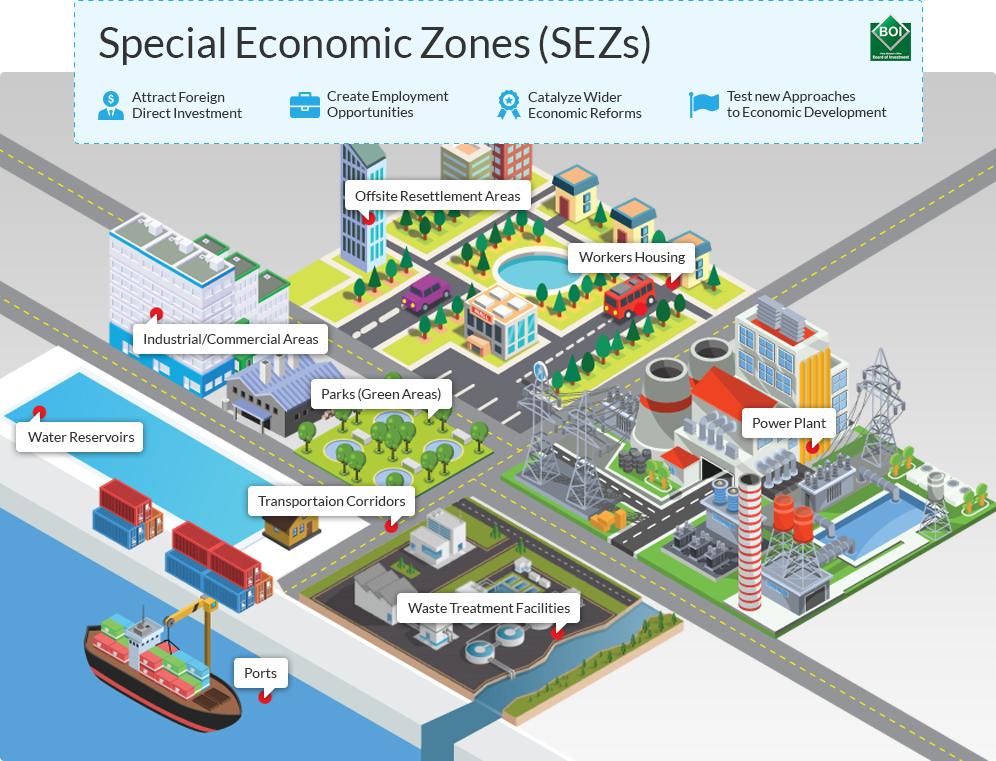Since establishment of modern Special Economic Zone in Ireland in 1959, a boom of SEZ has been witnessed in East Asian and Latin America during 1970. As of today, 5400 SEZs in 147 countries are working. SEZ has seen a mixed approach of success and failures. The time of Horizon to gauge success of any SEZ is 10-15 years. Pakistan has similarly strived to develop SEZs in different provinces/ selected areas, however, true potential could not be accrued due to various limitations. CPEC has knocked the opportunity to establish new SEZ with revised strategies to bring economic dividends for awaited prosperity in the country.
Comparing the incentives given by regional countries mainly China, India, Bangladesh, and Cambodia vis-à-vis Pakistan, it has come to light the incentives given by Pakistan are much less. Although Chinese have their interests in SEZ, therefore Pakistan may accrue the dividends, however, Act may be revised so that FDI from other investors can easily be attracted.
Actualization of SEZs is likely to have following impact on socio-economic landscape of Pakistan: –
- SEZs will work as a strong economic incentive as it would initially accrue 2% growth in GDP. Since, successful countries have gained 14% to 26% growth in the economy, therefore, as an average 10 % growth is expected with development of all SEZs.
- It will introduce reforms in improving domestic business environment, productive capacity, export base, and enhance commercial attractiveness for more foreign investments.
- Industrialization may help creating jobs i.e. approximately 1.5 million initially and more than 2 million by 2025 for the country’s large under-employed population, especially growing educated workforce, thus turning them into an economic dividend.
- SEZs may enable domestic industries on a higher path of the learning curve. Capacity-building efforts through vocational and technical training may help local workforce to catch up in quality skills.
- Pakistani diaspora may be attracted with their skills and knowledge along with their accumulated capital for more profitable prospects in the country.
- SEZs may provide a platform to Global firms seeking their production and trade in increasingly complex global value and supply chains to reap the benefits, which Pakistan otherwise missed.
Pakistan faces a number of challenges that so far have restricted industries to realize their potential growth. Though efforts have been made time to time for addressing some of the issues at policy framework level, however, few envisaged challenges still continue to pose threats to SEZs under CPEC: –
- Political instability causing political polarization considered as a major obstacle to the completion of CPEC. Although CPEC Authority has been established but on Presidential Orders, which may become a political stumbling block at later stages.
- Pakistan’s existing industrial zones like textiles and automobile manufacturers could not enhance capacity despite subsidies by government.
- Government agencies, do not have much experience and knowhow in industrial zones management and operations especially dealing with foreign investors. This may undermine implementation capacity.
- Provision of cost effective and uninterrupted utilities as well as proximity to road, rail, sea and air ports may continue to pose short to medium term challenge for some of the SEZs.
- Dispersal of industries across country, unskilled human resource, lack of modern technology and high business cost may cede space to Chinese human resource to fill the gap.
In order to reap true benefits from SEZ of CPEC, following strategic policy directions are proposed:
Build political consensus on SEZs by fostering debates in the National and Provincial legislature.
- CPEC Authority should work to overcome/resolve and coordinate all provincial and federal issues as ‘one team’ for overall success of the SEZs.
- Capacity building of Government agencies through Chinses SEZ may be developed to attain knowhow in industrial zones management and operations.Special customs rules may be enacted and staff be trained to facilitate SEZs’s trade on efficient basis without bureaucratic hurdles and corruption; especially minimizing time involved in various procedures.
- Establish modern vocational and technology institutions to produce required human skills for SEZs in cooperation with Chinese vocational training institutions..
- Early provision of cost effective and uninterrupted utilities as well as road link, may be established at the earliest.Act 2016 may include clauses to impose restrictions on use of labour i.e. employment of local and Chinese labor for certain period for mutual learning and proficient use of Chinese technological tools and machines, thereafter local workforce to be utilized to benefit from SEZs.
- Local industry may be encouraged to establish supplier firms to locate themselves in nearby SEZs to draw maximum benefits.
- Negotiate with Chinese government to secure duty-free status to exports originating from SEZs. Special free trade agreement in this regard may be concluded at the earliest.
SEZs are used as a tool for economic reforms and economic integration. These zones are a fruitful strategy for promoting trade, employment and economic growth. There is a need to fast track the establishment processes, simultaneous focusing on human resource development and capacity enhancement to fully benefit from the potential of SEZs.




